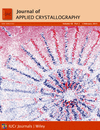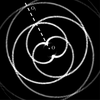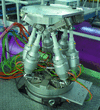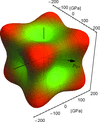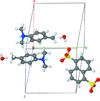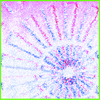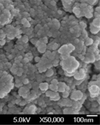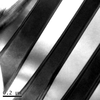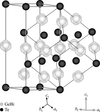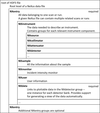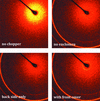issue contents
February 2015 issue

Cover illustration: A scanning transmission X-ray microscopy map obtained from a holographic image scan of a Siemens star test pattern. Courtesy of Osterhoff et al. [J. Appl. Cryst. (2015), 48, 116-124].
editorial
Free 

A new editorial from the three Main Editors of Journal of Applied Crystallography (JAC) updates authors and readers, alike, on current JAC developments.
research papers
Download citation


Download citation


Open  access
access
 access
accessA detailed comparison of single-crystal diffraction data collected with Ag Kα and Mo Kα microsources (IµS) indicates that the Ag Kα data are better when absorption is significant. Empirical corrections intended to correct for absorption also correct well for the effects of the highly focused IµS beams.
This paper, in which new sets of special directions (SDs) for cubic structures are proposed, is devoted mainly to practical applications of SDs. Taking into account experimental uncertainty, an optimal strategy for experimental investigations is discussed.
A novel approach to contrast variation with small-angle X-ray scattering based on the constitution of a solvent density gradient in a glass capillary is presented and used to characterize the mean size and size distribution of a colloid dispersion as well as to determine the electron density distribution of the suspended nanoparticles.
The peculiarities of scroll nanotube structure and associated diffraction effects in the context of electron diffraction are described. Diffraction identification criteria for distinguishing scroll nanotubes from coaxial tubes are proposed. Simulation of electron diffraction patterns from scroll nanotubes is performed for comparative studies with experimental patterns.
The effect of different substrates on the crystalline characteristics and superconducting properties of Bi2Sr2CaCu2O8+δ (Bi2212) thin films prepared by the Pechini sol–gel method was investigated.
Two-dimensional real-space functions obtained from small-angle scattering patterns contain valuable information on the size, shape and internal microstructure of materials.
The ultra-small-angle X-ray scattering (USAXS) technique is used to investigate and quantify second-phase particles in Zircaloy-4 under various heat-treatment conditions. Transmission and scanning transmission electron microscopy are also used to interpret and substantiate the results from USAXS experiments.
A description of the KWS-1 small-angle neutron scattering diffractometer at the Jülich Centre for Neutron Science (JCNS) and its scientific application is provided.
Grazing-incidence-angle versus conventional sin2ψ X-ray diffraction analysis techniques applied to resdiual stress measurements are investigated in terms of bias assessment and applicability.
An in situ powder diffraction cell for laboratory instruments is introduced, which allows studies to be carried out under elevated gas pressures and temperatures.
Open  access
access
 access
accessAn algorithm to compute stoichiometrically correct molecular formulae from crystal structures is proposed. The algorithm's output is suitable for high-volume automated searches in chemical databases and for linking crystallographic and chemical information.
A comparison between an experimental setup and simulations of a spin-echo-modulated small-angle neutron scattering instrument reveals important information on how to obtain the highest contrast by fulfilling the spin-echo condition.
Crystallographic analyses of deformation transfer mechanisms across the ferrite/cementite interface in fine lamellar pearlite are presented. Slip planes and Burgers vectors of full and partial dislocations in cementite have been proposed on the basis of the results of atomistic simulations of stacking faults for some planes of cementite.
A technique for the ab initio derivation of the Bravais lattice from the Kikuchi bands detected from a single electron backscatter diffraction pattern has been successfully developed.
Open  access
access
 access
accessMultilayer zone plates can be used for holographic imaging without an order-sorting aperture.
A detailed design study for the employment of a Laue lens in nuclear medicine is presented. The study facilitates a thorough understanding of how each system parameter affects the efficiency, the resolution and the field of view of the lens. The study has been carried out both analytically and through simulations performed with a custom-made Monte Carlo code.
Single-phase biocompatible bone-like nanocrystalline Zn-doped A-type carbonated hydroxyapatite (A-cHAp) has been synthesized by mechanical alloying of a mixture of CaCO3, CaHPO4·2H2O and ZnO powders. Zn2+ cations are substituted at the ninefold-coordinated Ca2+ sites in the A-cHAp unit cell.
Methods for numerically evaluating cylindrical absorption corrections that fully utilize radial symmetry to simplify distance calculations are presented. An analysis of the resulting data suggests that the best quality transmission diffraction data will generally be obtained when strongly absorbing samples are diluted by a factor of F = (4/3)μR in a maximal radius capillary (μ is the linear absorption coefficient for the sample and R is the capillary radius).
Diffraction/scattering computed tomography was achieved using a laboratory diffractometer, making this technique available to a broader scientific community.
A new parallel and GPU version of a TREOR-based algorithm for indexing powder diffraction data is presented.
A new method has been developed for calculating pair distribution functions (PDFs) of organic compounds. The approach distinguishes between intra- and intermolecular atom–atom distances and results in an improved fit to the experimental PDF curves.
With the help of group-theoretical analysis and a transmission electron microscopy study of domain orientation as well as the domain switching under mechanical load, the ferroelastic nature of the perovskite–brownmillerite phase transition in SrCo0.8Fe0.2O2.5 oxide with mixed ion–electron conductivity is revealed.
A geometric approach to describe and refine anisotropic domain morphology in common Rietveld refinements is provided and implemented in the TOPAS environment. The approach provides physically valid descriptions for the effect on peak broadening of three geometric models and allows a direct interpretation of refined parameters.
The mechanism of preferential nucleation of [ ]-oriented GaN faceted twins on an SiO2-patterned m-plane sapphire substrate is proposed, which explains the experimental results well.
]-oriented GaN faceted twins on an SiO2-patterned m-plane sapphire substrate is proposed, which explains the experimental results well.
Download citation


Download citation


The real structure of metastable Ge4Bi2Te7 is elucidated with the three-dimensional difference pair distribution function (3D-ΔPDF) method. It can be explained as derived from the rocksalt type by layer-like vacancy ordering.
CCDC reference: 1040739
An EBSD-based crystallographic technique for the determination of angle–axis pairs of misorientation for twinning is developed and applied to rhombohedral twinning in hematite, which yielded 85°〈 〉 as an alternative symmetry description.
〉 as an alternative symmetry description.
In list mode metadata can be included in the neutron event stream in order to achieve high time resolution of neutron scattering experiments in repeatable processes. Combining large amplitude oscillatory shear rheology and reflectometry illustrates the advantages and limitations of this new technique.
A fixed path length sample holder for cryoSAXS was microfabricated and tested. The holder has superior scattering properties, holds sub-microlitre sample volumes and solves many of the issues associated with previous non-fixed path length sample holders for cryoSAXS.
The crystalline structure formed by charged-stabilized asymmetric dumbbell-like colloidal particles was studied using small-angle X-ray scattering with microradian resolution. It was found that the crystals contain only 1.5% of stacking faults, which is a very high degree of stacking order for colloidal crystals. The high lattice symmetry indicates that these were plastic crystals, in which asymmetric colloidal particles are able to rotate freely.
Different protocols for calibrating electron pair distribution function measurements are explored and described for quantitative studies on nanomaterials.
Two-dimensional reciprocal space maps from irradiated single crystals with realistic defect structures are computed using a Monte Carlo approach. The calculations are accelerated using multiprocessing and GPU computing.
Open  access
access
 access
accessX-ray diffraction-based structural analysis results of possible direct bandgap Si/Ge superlattices composed of monolayer thin deposits are presented, together with theoretical predictions and first optical measurements.
A laboratory instrument with the ability to spatially resolve energy-dispersed X-ray powder diffraction patterns taken in a single snapshot has been developed. The experimental arrangement is based on a pinhole camera coupled with a pixelated spectral X-ray detector.
An unusual low-temperature magnetic anomaly in Ca2Fe2O5 has been investigated by single-crystal neutron Laue diffraction under zero- and low-magnetic field (35 Oe = 35 × 103/4π A m−1) conditions using a custom-designed sample environment.
This paper describes the design and use of a custom battery for operando neutron powder diffraction, providing guidance for researchers studying the phase evolution and structure of electrode materials using this approach. Example studies and results are given.
Open  access
access
 access
accessThe in situ three-point bending of a single self-suspended Au nanowire is visualized by micro Laue diffraction. The nanowire deflection is inferred from the displacement of Laue spots and it is well described by finite element analysis taking into account geometric nonlinearities and the elastic constants of bulk Au.
short communications
A self-standing curved Ge crystal focused hard X-rays by diffraction in Laue geometry through asymmetric (220) bent planes. The sample showed diffraction performance better than for any mosaic crystal under equal conditions.
computer programs
Open  access
access
 access
accessA description is presented of the NeXus data format for X-ray and neutron scattering and muon spectroscopy.
The program SIR2014 for crystal structure solution is described.
addenda and errata
Free 

Free 

Open  access
access
 access
accessErrors in the article by Fukamachi, Jongsukswat, Ju, Negishi, Hirano & Kawamura [J. Appl. Cryst. (2014), 47, 1267–1272] are corrected.


 journal menu
journal menu








